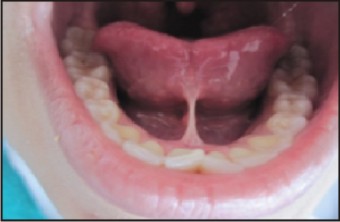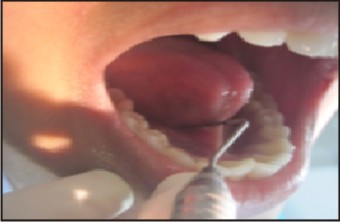Introduction
The lingual frenum is a mucosal fold that connects the bottom of the body of the tongue to the floor of the mouth and to the mandibular bone. When the frenum is thick , tight and/or its place of insertion limits the mobility of the tongue, it can result in Tongue Tie which iscalled as ankyloglossia (from the Greek "ankylos" which means tied and "glossa" which means tongue) [Various authors, 1975]. Ankyloglossia is an embryological anatomical malformation that commonly affects males more as compared to females in a ratio of 3:1. It occurs in newborns with an incidence of about 5%, more frequently as an isolated event and sometimes it can be seen associated with various malformative syndromes such as Simpson-Golabi-Behemel Syndrome, Optiz Syndrome, Beckwitz-Wiedemann Syndrome, Orofacial-digital Syndrome; cleft palate[1]. If ankyloglossia generates mechanical limitations and functional challenges, surgical reduction of the frenum is indicated, followed by speech therapy for an immediate rehabilitation of the lingual muscle.[2]
Embrylology
During intrauterine life, a strong tissue cord guides the development of oral frenulum which is positioned in the centre of the mouth and after the child is born, this lingual frenulum continues to guide the position of erupting teeth. With the growth of the child, it recedes and becomes thin.. In some cases, the frenulum is especially tight, or it fails to recede and may cause tongue immobility resulting in ankyloglossia. So ankyloglossia can be defined as a developmental anomaly of the tongue which is characterized by an abnormally short, thick lingual frenum resulting in limited tongue movement[3]. Various functional problems caused by ankyloglossia includes ; Difficulty in breastfeeding caused by the lingual hypomobility which results in inability of the infant to squeeze the nipple against the upper arch and hard palate during milk suction, Persons with ankyloglossia will have difficulty in swallowing as for swallowing a progressive push of the tongue apex onto the retroincisal-palatal spot is then followed by the medium and posterior area of the tongue pressing on the hard palate first and soft palate after, thereby ending on the wall of the pharynx and these movements are restricted in case of ankyloglossia.
Various surgical procedures like excision, Millers technique, V-Y plasty and Z-plasty are being practiced to revise lingual frenum. Now the purpose of this report is to describe ankyloglossia, its clinical signicance, and the promising result from multiple Z frenuloplasty.
Case Assessment
A 22 year-old female patient reported to Department of periodontolgy and oral implantology with the chief complaint of improper speech. On clinical examination it was seen that patient had ankyloglossia with thick frenum, restricted tongue movements like protrusion, and lifting of the tip of the tongue and a bifid or heart shape of the anterior tip of the tongue (Figure 1, 2). Because the tongue is a muscle, which in young children is flexible and often difficult to stabilize, placing a dental instrument at the insertion point and approximating the tip of the tongue determine this measurement. A UNC 15 then was used to measure this distance. (Figure 3).
The case was assessed clinically by Kotlow’s criteria in which normal range of motion of the tongue was assessed[4], Hazelbaker’s assessment tool to observe the functional movement and appearance of the tongue[5], and speech analysis to identify and rectify defective speech. Patient was asked to pronounce certain words which start from “I,” “th,” “s,” “d,” and “t” to check the accuracy of the word pronunciations. Postural evaluation was also made asaltered postures are present in individuals withankyloglossia. Postural Examination in lateral view showed body leaning anteriorly with head and shoulders projected forward in relation to the buttocks (front scapulum) and body barycenter moved forward[6].
 | Figure 1: Clinical Picture Showing Ankyloglossia
 |
 | Figure 2: Front View
 |
 | Figure 3: Measurement With Unc 15 Probe
 |
Procedure
Upon diagnosis of an ankyloglossia, after obtaining informed consent, the following procedures were carried out for correction of lingual frenum. Local anesthetic infiltrations are given locally around the frenulum and palatally using 2 cartridges of 2 % lignocaine with 1:80000 adrenaline. A black silk suture was placed through the tip of the tongue to allow the surgeon to retract the tongue and hold it in place. A vertical incision was made on the lingual frenulum. Horizontal incisions were made at 90 degrees to the vertical incision. The rectangular flaps were transposed in a Z-plasty manner. Multiple Z-plasties in series were used for lengthening of the tongue. Closure of the flaps was done using 3-0 vicryl sutures[7] (Figure 4). Postoperatively the tongue length was measured and was found to be 18 mm. There was satisfactory improvement in movements of the tongue and speech. After the above procedure, patient was discharged and post-operative instructions were given. Patients were asked to maintain a soft diet for a week, take analgesics and antibiotics and to maintain good oral hygiene. Patient was asked to carry out few tongue exercises to develop new muscle movements, particularly those involving tongue-tip elevation and protrusion, inside and outside of the mouth as well as to increase kinesthetic awareness of the full range of movements the tongue and lips can perform. Following is the tongue exercises:
 | Figure 4: Sutures Given
 |
1. Stretch tongue up towards your nose, then down towards the chin. Repeat.
2. After opening the mouth wide front teeth are touched with the tongue with mouth still open.
3. Licking of whole upper and lower lip from one side to the other.
4. Poke the tongue out as far as it can go.
5. Shut your mouth and poke it into your left cheek to make a lump. Do the same on the other side.
After postoperative wound healing patient was referred to speech therapist for speech modification
Result
Preoperative and postoperative scores were recorded. After 3 month, 6 month and 1-year follow-up (Figure 5), significant improvement in prognosis of symptoms of ankyloglossia was observed Free tongue movement increased from 13 to 17 mm. Functional score, appearance score and speech also improved. On postural Examination in lateral view, correction of the head and neck postion 6 months and 1 year after lingual frenectomy was seen.
 | Figure 5: Clinical Picture After 1 Year
 |
Discussion
Today several surgical procedures have been implemented to revise abnormal frenula. These include excision, Millers technique, V-Y plasty and Z-plasty. However, it is seen that frenectomies commonly fail due to a high risk of reoccurrence and hypertrophic scarring[4]. The risk of failure can be reduced by using a multiple Z-Frenuloplasty By using this multiple Z-Frenuloplasty technique it was found that this results in less soft tissue tension, lengthening of the tongue, minimal scarring and improved lip or tongue function. The usual Z-plasty consists of two triangular flaps that transpose synchronously with each other, recruiting tissues from one axis and redistributing tissues along another axis[8]. It has a number of modifications which are practical and applicable. Multiple Z-plasties in series has been used in our case for a number of reasons. The lingual frenum was divided into a number of segments, each with a Z-plasty designed in series. It alters the form of lateral tension and has advantages from a vascular point of view[9]. With a co-operative patient this technique can easily be performed under local anaesthetic and unlike other techniques there is no relapse of the Frenulum making it a very reliable treatment. Heller et al 2005[10] compared the treatment outcome for Z-frenuloplasty and the traditional horizontal to vertical frenuloplasty in the management of Ankylogossia. The results revealed the Z-frenuloplasty to be a more superior technique, showing an improvement of Frenulum length and tongue protrusion of 37.5 ± 13.5mm (P < 0.001) compared to the other method at 36.2 ± 7.6 mm (P < 0.001), respectively. Furthermore, it was also found that 91% of the patients who underwent the Z-frenuloplasty showed improvement in speech compared to only 40% in those who underwent the horizontal-to-vertical frenuloplasty.
Overall the multiple Z-Frenuloplasty procedure is considered to be safe, cost effective and results in better functional and aesthetic appearance. This procedure allows for tissue healing by primary intentions; increasing recovery and reducing the risk of tissue contractures. Extensive division of a lingual frenulum can damage the blood vessels in the floor of the mouth. Very rare cases of sublingual haematoma and Ludwigs angina have been reported in the literature It is therefore important that this procedure is only carried out by an experienced clinician as limited evidence currently available on this procedure, further research is proposed in the field to compare the different surgical frenectomy procedures.
Conclusion
Tongue tie affects a considerable number of infants and children throughout the world. Early diagnosis of ankyloglossia is important for correct morpho-functional growth in the child. However it is important that accurate information and guidance is givento the patient and parents with regard to the indications and potential benefits of tongue-tie revision. This case report offer guidelines which can be used by general and pediatric dentists for diagnosis and treatment of a tongue restriction resulting from ankyloglossia.
References
1. Kloars T. Familial ankyloglossia (tongue tie). Int J PediatrOtorhinolaryng.2007;71:1321-1324.
2. Campan P, Baron P, Duran D, Casteigt J. Lingual frenectomy: a therapeutic protocol. A technic for frenectomy with 2 incision lines combined with active postoperative kinesitherapy during and after healing. Schweiz Monatsschr Zahnmed. 1996;106(1):45-54.
3. H. E. Darshan and P. M. Pavithra, “Tongue tie: from confusion to clarity-a review,” International Journal of Dental Clinics.2011; 3:48–51.
4. L. A. Kotlow, “Ankyloglossia (tongue-tie): a diagnostic and treatment quandary,” Quintessence International.1999;30(4):259–262.
5. Hazelbaker AK. The Assessment Tool for Lingual Frenulum Function (ATLFF): Use in a Lactation Consultant Private Practice. Pasadena, CA: Pacific Oaks College; 1993. Thesis.
6. Scoppa F. Gosso postural syndrome. Annali Stomatologia 2005;54(1):27-34.
7. Vyloppilli S, Prathap A. Lingual frenectomy using multiple series Z-plasty. J. Maxillofac. Oral Surg. ;June 2010: 9(2)195–197
8. Hudson DA Some thoughts on choosing a Z-plasty: the Z made simple. Plast Reconstr Surg. 2000; 106(3):665–671
9. McGregor IA (1995) Fundamental techniques of plastic surgery, 9th edn. Churchill Livingstone, Edinburgh.
10. Heller J, Gabbay J, O'Hara C, Heller M, Bradley JP.Improved ankyloglossia correction with four-flap Z-frenuloplasty. Ann Plast Surg. 2005; 54(6):623-8
|